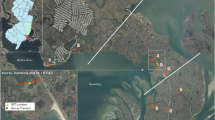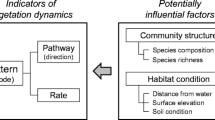Abstract
Although large-scale transformation of Everglades landscapes has occurred during the past century, the patterns of association among hydrologic factors and southern Everglades freshwater marsh vegetation have not been well-defined. We used a 10-year data base on the aquatic biota of Shark Slough to classify vegetation and describe plant community change in intermediate- to long-hydroperiod Everglades marshes. Study area marsh vegetation was quantitatively grouped into associations dominated by 1)Cladium jamaicense, 2) a group of emergents includingEleocharis cellulosa, Sagittaria lancifolia, andRhyncospora tracyi, 3) taxa associated with algal mats (Utricularia spp. andBacopa caroliniana), and 4) the grassesPanicum hemitomon andPaspalidium geminatum. During the decade evaluated, the range of water depths that characterized our study sites approached both extremes depicted in the 40-year hydrologic record for the region. Water depths were near the long-term average during the mid-1980s, declined sharply during a late 1980s drought, and underwent a prolonged increase from 1991 through 1995. Overall macrophyte cover varied inversely with water depth, while the response of periphyton was more complex. An ordination analysis, based on plant species abundance, revealed that study area vegetation structure was associated with hydrologic patterns. Marsh plant community structure showed evidence of cyclic interannual variation corresponding to hydrologic change over the decade evaluated. Lower water depths, the occurrence of marl substrates, and high periphyton cover were correlated. These factors contributed to reduced macrophyte cover in portions of the study area from which water had been diverted.
Similar content being viewed by others
Literature Cited
Armentano, T.V, R.F. Doren, W.J. Platt, and T. Mullins. 1995. Effects of Hurricane Andrew on coastal and interior forests of southern Florida: overview and synthesis. Journal of Coastal Research 21:111–144.
Browder, J.A. 1981. Perspective on the ecological causes and effects of the variable algal composition of southern Everglades periphyton. U.S. National Park Service, Homestead, FL, USA. Report T-643.
Browder, J.A., P.J. Gleason, and D.R. Swift. 1994. Periphyton in the Everglades: spatial, variation, environmental correlates, and ecological implications. p. 379–418.In J. Ogden and S. Davis (eds.) Everglades: the Ecosystem and Its Restoration. St. Lucie Press, Delray Beach, FL, USA.
Craft, C.B., J. Vymazal, and C.J. Richardson. 1995. Response of Everglades plant communities to nitrogen and phosphorus additions. Wetlands 15:258–271.
Craighead, F.C. and V.C. Gilbert. 1962. The effects of Hurricane Donna on the vegetation of southern Florida. Quarterly Journal of the Florida Academy of Sciences 25:1–28.
David, P.G. 1996. Changes in plant communities relative to hydrologic conditions in the Florida Everglades. Wetlands 16:15–23
Davis, S.M., L.H. Gunderson, W.A. Park, J.R. Richardson, and J.E. Mattson. 1994. Landscape dimension composition, and function in a changing Everglades ecosystem. p. 419–444.In J. Ogden and S. Davis (eds.) Everglades: the Ecosystem and Its Restoration St. Lucie Press, Delray Beach, FL, USA.
De Angelis, D.L., and P.S. White. 1994. Ecosystems as products of spatially and temporally varying driving forces, ecological processes, and landscapes: a theoretical perspective. p. 9–27.In: J. Ogden and S. Davis (eds.) Everglades: the Ecosystem and Its Restoration. St. Lucie Press, Delray Beach, FL, USA.
Gunderson, L.H., D.P. Brannon, and G. Irish. 1986. Vegetation cover types of Shark River Slough, Everglades National Park, derived from LANDSAT thematic mapper data. National Park Service. Everglades National Park. Homestead, FL, USA. SFRC-86/03.
Gunderson, L.H. 1989 Historical Hydropatterns in wetland communities of Everglades National Park. p. 1099–1111.In R.R. Sharitz and J.W. Gibbons (eds.) Freshwater Wetlands and Wildlife. U.S. Department of Enegry, Oak Ridge, TN, USA.
Gunderson, L.H. 1994. Vegetation of the Everglades: determinants of community composition. p. 323–340.In J. Ogden and S. Davis (eds.), Everglades: the Ecosystem and Its Restoration. St. Lucie Press. Delray Beach, FL, USA.
Herndon, A., L. Gunderson, and J. Stenberg. 1991. Sawgrass (Cladium jamaicense) survival in a regime of fire and flooding. Wetlands 11:17–28.
Hill, M.O. 1979a. DECORANA, a FORTRAN program for detrended correspondence analysis and reciprocal averaging. Microcomputer Power, Ithaca, NY, USA.
Hill, M.O. 1979b. TWINSPAN, a FORTRAN program for arranging multivariate data in an ordered two-way table by classification of the individuals and attributes. Microcomputer Power, Ithaca, NY, USA.
Jordan, F., H.L. Jelks, and W.M. Kitchens. 1997. Habitat structure and plant community composition in a northern Everglades wetland landscape. Wetlands 17:275–283.
Kolipinski, M.C. and A.L. Higer. 1969. Some aspects of the effects of the quantity and quality of water on biological communities in Everglades National Park. U.S. Geological Survey, Tallahassee, FL, USA. Open File Report 69007.
Kushlan, J.A. 1981. Sampling characteristics of enclosure fish traps. Transactions of the American Fisheries Society 110:557–562.
Loftus, W.F. and A.M. Eklund. 1994. Long-term dynamics of an Everglades small-fish assemblage. p. 461–483.In J. Ogden and S. Davis (eds.) Everglades: the Ecosystem and Its Restoration. St. Lucie Press, Delray Beach, FL, USA.
Pimm, S.L., G.E. Davis, L. Loope, C.T. Roman, T.J. Smith III, and J.T. Tilmant. 1994. Hurricane Andrew. BioScience 44:224–229.
Potvin, C., M.J. Lechowicz, and S. Tardiff. 1990. The statistical analysis of ecophysiological response curves obtained from experiments involving repeated measures. Ecology 71:1389–1400.
Roman, C.T., N.G. Aumon, J.C. Trexler, R.J. Fennema, W.F. Loftus, and M.A. Soukup. 1994 Hurricane Andrew’s impact on freshwater resources. BioScience 44:247–255.
Rose, P.W., and P.C. Rosendahl. 1981. Landsat hydrobiological classification for an inland fresh water marsh within Everglades National Park. American Water Resources Association, Minneapolis, MN, USA.
Steward, K.K. and W.H. Ornes. 1975. The autecology of sawgrass in the Florida Everglades. Ecology 56:162–171.
Ulanowicz, R.E. 1995.Utricularia’s secret: the advantage of positive feedback in oligotrophic environments. Ecological Modelling 79:49–57.
Urban, N.H., S.M. Davis, and N.G. Aumen. 1993. Fluctuations in sawgrass and cattail densities in Everglades Water Conservation Area 2A under varying nutrient, hydrologic, and fire regimes. Aquatic Botany 46:203–223.
White, P.S. 1994. Synthesis: vegetation pattern and process in the Everglades ecosystem. p. 445–458.In J. Ogden and S. Davis (eds.) Everglades: the Ecosystem and Its Restoration. St. Lucie Press, Delray Beach, FL, USA.
Wood, J.M. and G.W. Tanner. 1990. Graminoid community composition and structure within four Everglades management areas. Wetlands 10:127–149.
Zar, J.H. 1984. Biostatistical Analysis. Prentice-Hall. Englewood Hills, NJ, USA.
Author information
Authors and Affiliations
Rights and permissions
About this article
Cite this article
Busch, D.E., Loftus, W.F. & Bass, O.L. Long-term hydrologic effects on marsh plant community structure in the southern Everglades. Wetlands 18, 230–241 (1998). https://doi.org/10.1007/BF03161658
Received:
Revised:
Accepted:
Issue Date:
DOI: https://doi.org/10.1007/BF03161658




